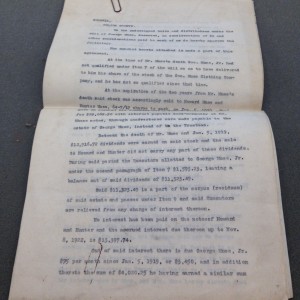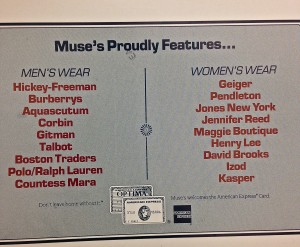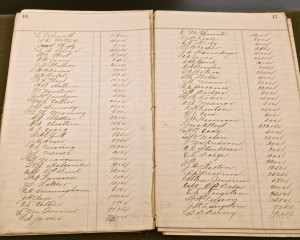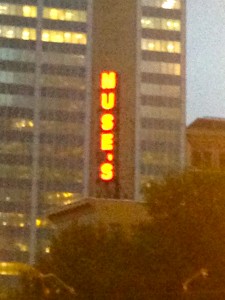Hello! I’m Diana, student at Georgia State University located at the heart of Downtown Atlanta. As a student, I have embraced this great city and its history. One of my favorite buildings in Atlanta is the Muse Building. This structure was once the site of one of the largest retailers in the city, and perhaps, the Southeast. I have had fun researching and learning about this Muse’s and I hope that fellow residents, newcomers, and students enjoy reading.
This building is the site of George Muse’s concept to have a clothing store that catered to the elite residents of the South and of the entire country. Although he did not live to see his dream rise to reality, his vision survived and was brought to life by those who believed in his notion. The position of Muse’s building in Downtown Atlanta has influenced a city that has changed several times and continues to progress along with it.
THE ORIGIN OF MUSE’S
The George Muse Clothing Company began when Georgia was still in recovery from the Civil War. George Muse was born in Lafayette, Alabama. In 1867, two years after the war ended, he left the small farm town at 16 for Atlanta to seek employment. There, he was hired by Dr. R.P. Kimbro, owner of the Kimbro Store located at 38 Whitehall Street, present day Underground Atlanta. As a clerk, he learned about menswear and became sophisticated in the retail business. With the help of his stockholders, he bought the Kimbro Store in 1874 and established himself as an outfitter. [1]

A guide to shoe shopping.
Courtesy of Atlanta History Center. Geo Muses Clothing Company-Business File, Stacks 1.
GEORGE MUSE – A HOUSEHOLD NAME
Moving forward into the 20th Century, Muse had established himself and his store as one of the best places to shop for menswear. He had a large staff of employees. Among those employees, there were his partners who invested in the company as much as Muse did himself. In 1891, he partnered L.B. Parks and W.W. Orr to help run his expanding business. L.B. Parks came in as business man knowledge of the retail trade and W.W. Orr was his quick and accurate accountant. All three men were extremely active in the store. An article by The Atlanta Constitution in 1891 stated that Muse’s was the most familiar retail store of fine clothing and mentioned George Muse as a reputable man. “Mr. Muse is a tireless worker and has made a reputation that would be an honor to any man.” With his team, his business grew over the next ten years, and opened a new store in 1902. Over the next several years, Muse’s team worked hard to maintain their phenomenal success. W.W. Orr, especially, was extremely active among customers and hand wrote the account books he kept for Muse’s top clients.[2]

Bruce Galphin, Norman Shavin, Atlanta: Triumph of a People, an Ilustrated History, 1985, pg.212.
The original George Muse Clothing Company was located at 1-3-5 Whitehall Street was erected in 1902.
MOVING TO PEACHTREE STREET
There had been talk about moving Muse’s to downtown for a few years. In 1916, Asa. G. Candler, a famous Atlanta developer, began drafting a deal with the Hunnicutt Plumbing Company to buy their building located at 50 Broad Street NW. The company has been rapidly growing and Muse was now starting to have clients from all over the Southeast and travelers from the rest of the country. Asa G. Candler, Inc., a top developing company in Atlanta, and the Hunnicutt Family, finalized the contract to move the company.

Page of the contract between Candler and Hunnicutt. Emory University, Manuscript Collections No 881.
The new Muse’s building would extend to Broad Street and take up the entire Walton Street front between Peachtree and Broad. Work on the building would begin in the winter of 1920. [3] Unfortunately, George Muse did not foresee any of his company’s future. Muse died in his Midtown home on January 4, 1917 after a short illness. He left the company to his stockholders and family.
Muse passed away when his company was at the peak of their success. His son Howard Muse, Jr. took over as president. After his death, the annual stockholder meeting George Muse Sr. usually presided at, was held by the determined chairman of the company, W.W. Orr. Orr, had been with the company twenty-five years. He led the company in 1916 with their most profitable year. He led the way for the new site of the new Muse’s location.[4]

Asa Candler bought the Hunnicutt PlumbingBuilding in 1917. Emory University Library, Manuscript Collection No. 881.
MUSE’S DOWNTOWN
As the construction of Muse’s new store began, Candler called upon a team he used frequently for his finest structures. Local architect, Phillip Shutze, helped design the structure with Hentz, Reid, & Adler Architect Firm. Together they built a structure with a narrow shape and Italianate design, the same motif they used on the Downtown Rich’s Department Store. It has a simple base in limestone characteristics, and large elaborate window displays for attraction. The intricate cartouches frame the corner and side windows. Shutze designed with simple beige brick that matched the Nations Bank Building, located Broad Street.[4]
BECOMING A PART OF ATLANTA’S DOWNTOWN LIFE
The opening of Muse’s Downtown was a event that was waited upon arrival. This new building had seven stores that could carry all the exclusive and latest trends in the city. The opening of Muse’s was nothing short of a warm welcome. On Monday March 21, 1921, Muse’s opened in Downtown Atlanta to the public. The housewarming lasted from 9 A.M. until 10 P.M. and Paul Warwick from The Atlanta Constitution, covered the event. He noted that Muse’s “successfully combined business significance with social satisfaction.” He further detailed how the seven-story building was dedicated to menswear and had a new women’s shoe department. The entire building was ready for everyone to enjoy the massive window displays of the latest trends. Also, he observed how the sales representatives were not worried about making sales, but rather making sure that the customers were greeted and shown around the facility. Orr and Muse Jr. were present to shake hands with all the customers and accept everyone’s praise.[6]

Thousands Attend House-Warming at Handsome New Muse Store, Atlanta Constitution, March 22, 1921, pg. 7.
MUSE’S AT THE HEART OF THE CITY FROM 1930S THROUGH 1970S

Atlanta Resurgens: The First Hundred Years of City’s Progress, Promised & Philosophy, First National Bank of Atlanta, pg 79.
Through out the next thirty years, Muse’s maintained an immaculate reputation and business kept growing steadily. Stores expanded beyond Downtown and into Lenox Mall in Buckhead and small store inside the atrium of Grady Hospital. Although the company was expanding, the flagship store overshadowed its smaller counterparts. In 1933, Muse’s celebrated its 54th anniversary of establishment at the store. Since opening, Muse’s had added a millinery department, as well as, a lingerie and hosiery department for women. J. Harry Alexander became chairman of the board after W.W. Orr’s death in 1927 and continued to expand the brand.[7]

Michael Rose, Atlanta Then and Now, 2001, pg. 39. Fulton County Library.
Peachtree in 1973 and Muse across Woodruff Park.
WHO SHOPPED AT MUSE’S?
Through out my time researching this magnificent building, I have asked those who have helped me find material if whether or not they remember Muse’s and if they shopped there. I have had several responses from people who don’t remember and only a few that remember Muse’s as a high- end retail store that only had the best and latest trends.
Peggy Wood remembers shopping at Muse’s. The Atlanta native wrote in her book, Something Must be Done: One Black Woman’s Story, about her experience in the store. In the 1950s, Wood has a charge account for Muse. The store did not have segregated dressing rooms and one would pay for those privileges. She could stand out at the center of the dressing room area instead of staying behind close curtains. Everything at Muse’s was expensive for her thirteen dollar a week paycheck. She only shopped there for her mother and herself on occasion.[8]

Playing cards. Courtesy of Atlanta Historical Center, Geo Muse Clothing Company Business File, Stacks 1.

Muse’s personal mail to top clients. Courtesy of Atlanta History Center, Geo Muse Clothing Company Business File, Stacks 1.
THE FALL OF MUSE’S AND THE MARK IT LEFT ON ATLANTA
During the 1970s and 1980s, White Flight took place and the city’s residents left for the suburbs. This cause crime and illegal activity to rise in the downtown area and most businesses were affected, including Muse’s. In 1990, Muse’s filed for bankruptcy after many failed attempts to revive the company.[9]The building was sold to Aderhold Properties and transformed into lofts. Downstairs at its Peachtree Street Entrance is Anatolia’s Café, a Mediterranean style restaurant frequented by Georgia State students and employees of the financial district area. Muse’s roof top lights still light up to this day. While most people, cannot remember Muse’s, it will continue to stand and be an iconic building for many years to come. George Muse’s dream to have a great company came true, but the building has been the one left standing.
[1] “GEORGE MUSE DIES OF HEART FAILURE: Although He Had Been In Poor Health For Six Weeks, His Death Comes As A Surprise.” The Atlanta Constitution, January 5, 1917, pg. 1.
[2] “GEORGE MUSE & CO.: One of the Largest Clothing Establishments in the South.” The Atlanta Constitution, January 4, 1891, pg. 17.
[3] “GEORGE MUSE CO. GETS LONG LEASE ON NEW LOCATION: Handsome Store Will Be Erected by Asa G. Candler on the Present Site of Hunnicutt Building. OCCUPANTS TO VACATE ON THE FIRST OF 1920, The Present Quarters on Whitehall Street, Near the Viaduct, Will Be Subleased By Well-known Company.” The Atlanta Constitution, March 9, 1919, pg.d1.
[4] “W.W. ORR HEADS GEORGE MUSE CO.” The Atlanta Constitution, January 16, 1917, pg. 5.
[5] Gournay, Isabelle, AIA Guide to the Architecture of Atlanta, 1993 University of Georgia Press, Athens, pg. 30.
[6] Warwick, Paul. “Thousands Attend House Warming at Handsome New Muse Store, The Atlanta Constitution, March 22, 1921, pg. 7.
[7] “54th Anniversary is Observed By George Muse Clothing Co.” The Atlanta Constitution, March 22, 1933, pg. 5.
[8] Wood, Peggy. Something Must Be Done: One Black Woman’s Story, 2006 Syracuse University Press, Syracuse, pg. 49-50.
[9] “Muse’s Downtown Will Close.” The Atlanta-Journal Constitution, January 21, 1992, pg 1.
I’d like to thank the City of Atlanta the staff at Emory University Library, Fulton County Library, Atlanta Research Center, Samuel Gudger, Jeanette Cuevas, and Dr. Davis for their helpp.





